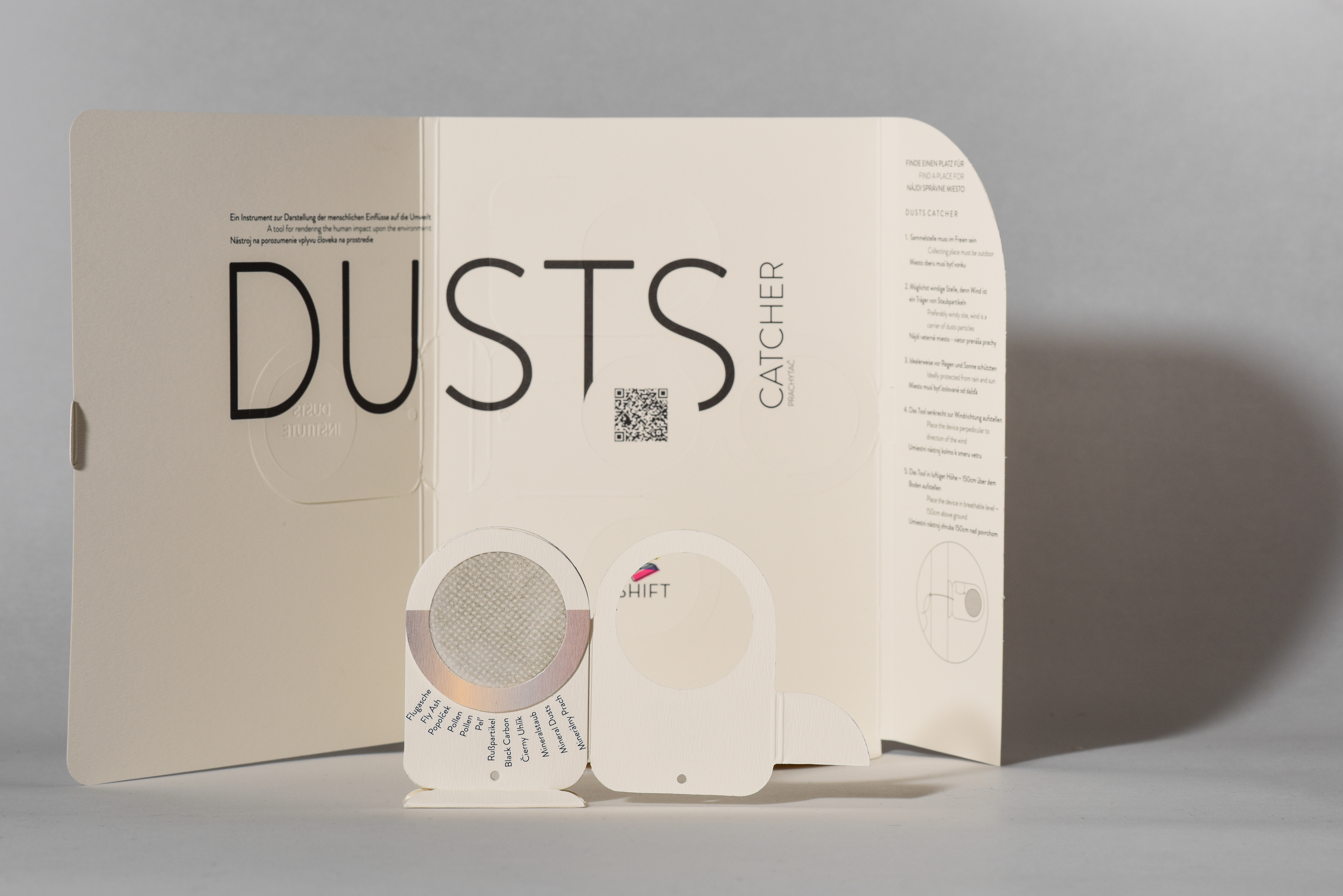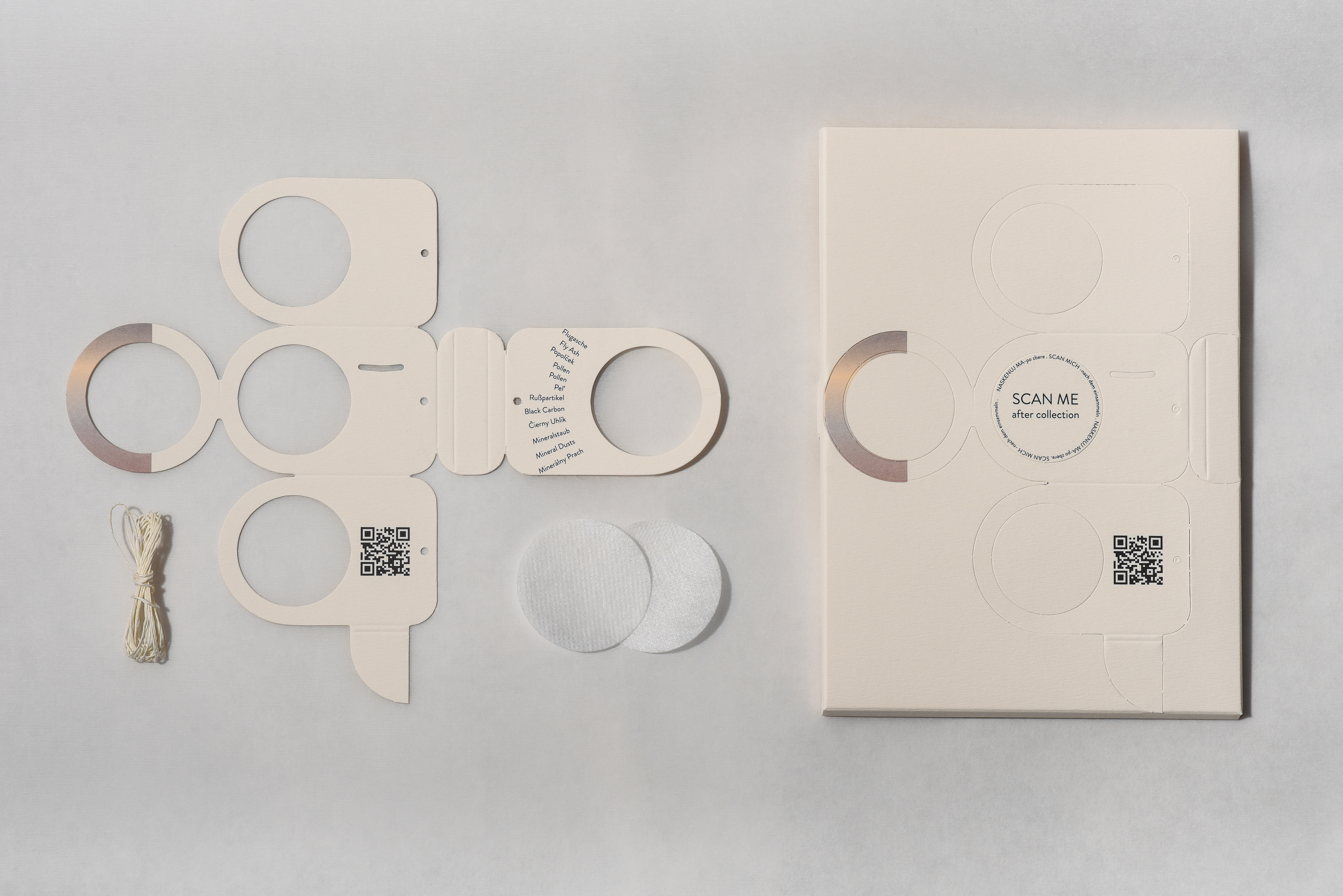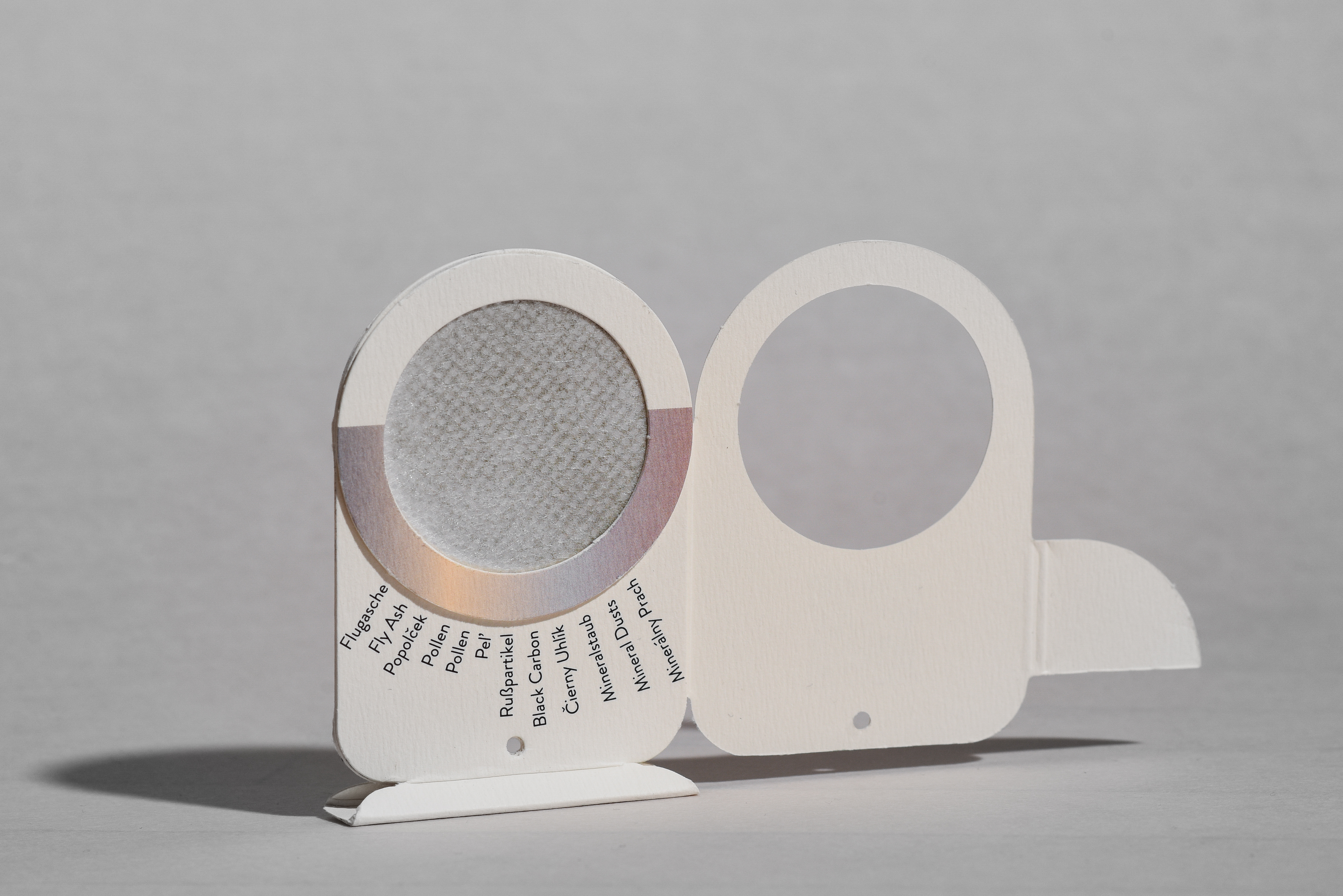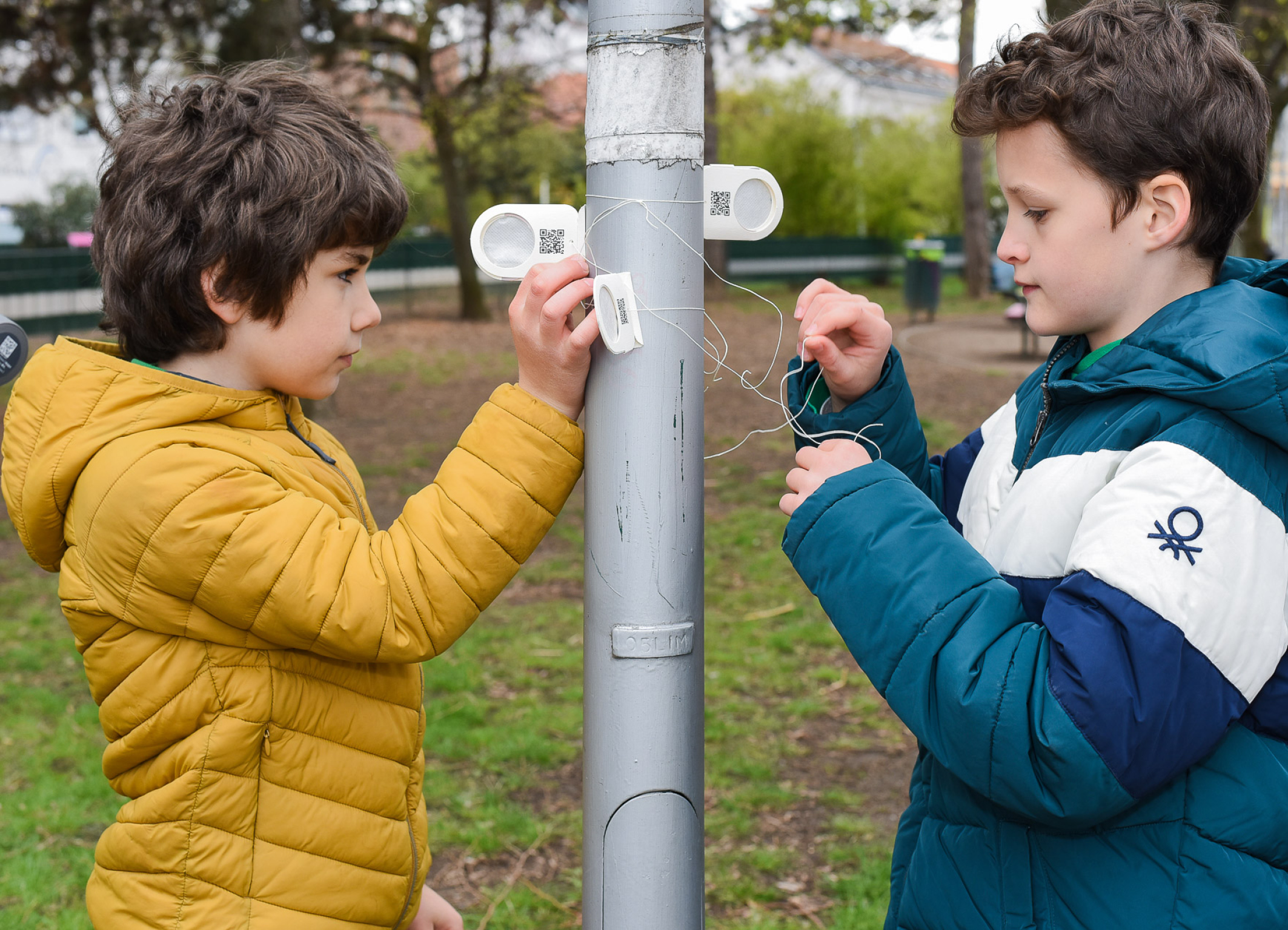Dusts Catcher Kit is a simple, foldable and fully recyclable tool for collecting and materialising airborne dusts. The nanofabric inserted into the folding paper device materialises the particulate matter by collecting dusts particles from the environment and it transforms otherwise invisible airborne dusts into visible and tangible aesthetical objects.
This D.I.T. project (Do It Together) initiates a movement that centres collaboration and artistic processes in order to propose a situated knowledge of climate awareness informed by various perspective of human and nonhuman lifeforms. They have been disregarded and undervalued by economic cycles; such as air we breathe with all particles that it carries and communities impacted by inequitable environmental policies and practises. As an interdisciplinary and collective artistic research project, our aim is to address these concerns and the understanding of environmental processes that are sometimes difficult to grasp. Therefore, our goal is to collect and materialise invisible airborne dusts from the air we breathe. Particulate matter is known to function as a carrier for many chemical and biological contaminants including viruses that float all around us while we are unable to feel or see them. Dusts Catcher Kit is a simple, foldable and fully recyclable tool for collecting and materialising airborne dusts. The nanofabric is inserted into the folding paper device that materialises the particulate matter by collecting dusts particles from the environment and it transforms otherwise invisible airborne dusts into visible and tangible objects. To find a proper collection place, the participant needs to consider the wind direction, since wind is a carrier of airborne dusts. Placing the device on the breathable level for one day ensures that the collected dusts is a good representation of the dusts particles we inhale. After the collection, the gradient tool might be used to identify the type of collected dusts.
Please highlight how the project can be exemplary in this context
This project takes the sustainability aspects very seriously. The ultimate goal during the production and development was to cut its carbon footprint as much as possible. Tracking app of carbon footprint calculator were used, while taking under consideration all measures how to eliminate carbon footprint; meetings were hold preferably online to reduce travel, all data have been stored offline, the slowest delivery options were used and express shipping method avoided, short distance delivery were realized by cargobike. Office electricity supply were chosen with highest percentage of renewable energy resources, team were eating vegan and from local markets, number of overhours cut to absolute zero.
Production of Dusts Catcher Kit was well planned to avoid any unexpected material loses. Main material is a recycled paper without chemical treatment. Design of the KIT reduce the usage of material: the actual device, Dusts Catcher, is a part of the envelope of the Dusts Catcher KIT, that can be popped up and folded by hand. Attached string for mounting the device on public space is natural, biodegradable. The entire device can be used multiple times, part of KIT is a number of nanofabric filters, that can be delivered back once the collection of dusts particles is over. These specimen are carefully stored for archival purposes and future projects. Atrament use for printing were carefully examined during the design process and eco atrament were chosen for printing despite its higher initial costs.
Project Dusts Catchers KIT is a showcase of sustainable project not only from the perspective of the concept and its materiality, but also human resources. Every aspects of the project from development to the delivery of the product to communities was carefully examined in order to eliminate carbon footprint as much as possible, yet maintaining fair-pay for all parties in the project. Therefore this project is truly the exemplary within the field.
Please highlight how the project can be exemplary in this context
The design of Dusts Catchers KIT was guided by a principle of augmentation of air pollution. The ultimate goal was to design a tool, that would bring this unwanted matter, usually in the periphery of our attention, back to contemporary discussion that would facilitate challenges of climate awareness that we must face nowadays. It means, that Dusts Catchers KIT is able to transform an ignored, rejected matter (air pollution) into a aesthetic object by augmenting our senses. This method has the ability to inform communities about the quality of the air they breathe. Decontruction and materialisation of data were one of the key principles during the design process. This project is a pioneer in re-defining on how aesthetics and quality of experience could reach far beyond functionality; Dusts Catchers KIT is a tool that raise awareness about human impact upon the environment by proposing a visual and tactile experience of otherwise invisible by-product of our lifestyle - airborne dusts.
Please highlight how the project can be exemplary in this context
This project takes the inclusion of public as a core principle in the creative process and data collection. Dusts Cathers KIT were designed to serve communities around globe to be informed about the quality of air they breathe and provide subsequent affordable tool of evidence about air pollution levels. We do not all breathe the same air was the initial statement that this project took into a careful investigation. During summer 2021 we have organised multiple Dusts Collection workshops in Berlin, Vienna, and Czech Republic with the aim to strive a discussion within local communities about the quality of the air. During our workshops we were particularly careful with the use of simple vocabulary and native language of the participants in order to maximise the reach of our project and do not exclude absolutely anyone regardless their nationality, age, skin colour or gender. Therefore our workshop are always offered in English, German, Arabic, Turkish, Czech and Slovak language. However, being inclusive means for us also to be mindful of our bodies and bodies of others. The Dusts Collection Walks therefore last around 1 hour, with several standing/sitting breaks in between, with a maximum walking distance around 1 km. The paths are planned barrier-free, stairs are avoided , obstacles are circumvented. In this way, we could welcome everybody, including people with limited capabilities.
Please highlight how this approach can be exemplary
By implementing art practise in scientific research, applying situated knowledge and working with Citizen Science practices, this project will nurture an augmented discourse on how to study airborne dusts in the air we breathe. Public engagement and knowledge accessibility are the core elements for the successful acknowledge human made particles as an essential part of the environment. In order to deal with the complexities of the proposed topic, Augmentation as a method aims to augment our sensorial experience and our perspective on airborne dusts. Augmentation connects and sensitises the public to the potentialities of airborne dusts particles.. By implementing atmospheric science into design and architecture, applying situational knowledge and working with the public, a discourse on how to co-exist with other life forms will be formed through the study of airborne particles.
Project Dusts Catchers Kit successfully raise awareness in the communities within Europe about the quality of the air we breathe through artistic research and citizen science and therefore provide a better understanding of local environment and belonging.
Please also explain the benefits that derived from their involvement.
Public Dusts Collection Workshop provide a base for discussion on the topic of air quality and raise awareness on how to understand it. Public engagement in the discussion during the workshop have been reflected in development of workshop tutorials, now able to serve wider audience. Data collected by public with Dusts Catcher have been archived and categorized for further artwork production and archive development.
This project particularly tackles the issue of air quality and invisibility of particular matter. It transforms global phenomena into local, tangible artistic object that inform communities about the quality of the air they breathe.
Project Dusts Catchers Kit continuously explored the inclusion of citizens in the creative process. Dusts Catchers were inspired by the scientific method of ambient air sampling where pollutants carried by air are captured on a medium (usually various types of fabrics) and analysed later to determine the amount and composition of air-borne pollutants. Moreover, by organising public collection walks, this project started to experiment with the notion of augmentation of the senses of the participants in order to locate air-borne dusts from a non-human perspective.
Please provide clear documentation, communication of methodology and principles in this context.
Dusts Catchers Kit puts special emphasis on the collaborative format of the project and on the inclusion of the public in the creative process. Airborne dusts collection is organized as a series of workshops where participants learn how to collect and identify air pollution. For this purpose, a special tool called Dusts Catcher was developed with instructions and tutorials on how to recognize particulate matter in the environment. The design of the tool is as inclusive as possible to serve a wide range of age groups: pupils and students, the general public, professionals, designers, architects and other professionals in related fields. Dusts Catchers KIT can be sent directly to the communities involved in the project - schools, leisure centres, associations. The results of the collection and analysis of Airborne Dusts on surfaces is possible to upload to a repository for further analysis of the results. The results of the public airborne dusts collections will be documented and processed. Throughout the project public participation practices are explored as a tool for raising awareness and knowledge transfer.





@Dusts Institute, 2021
Content licensed to the European Union.